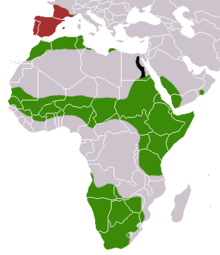Common genet
| Common genet | |
|---|---|
 |
|
| Scientific classification | |
| Kingdom: | Animalia |
| Phylum: | Chordata |
| Class: | Mammalia |
| Order: | Carnivora |
| Family: | Viverridae |
| Subfamily: | Viverrinae |
| Genus: | Genetta |
| Species: | G. genetta |
| Binomial name | |
|
Genetta genetta (Linnaeus), 1758 |
|
 |
|
| Common genet range (green - native, red - extant introduced, black - extinct introduced) |
|
The common genet (Genetta genetta), is a small viverrid indigenous to Africa that was introduced to southwestern Europe and the Balearic Islands. As it is widely distributed north of the Sahara, in savanna zones south of the Sahara to southern Africa and along the coast of Arabia, Yemen and Oman, it is listed as Least Concern on the IUCN Red List. It has also been recorded in Germany, Belgium and Switzerland.
Common genets have a slender, cat-like body, 43 to 55 cm (17 to 22 in) in length, and a tail measuring 33 to 52 cm (13 to 20 in). Males, with an average weight of 2 kilograms (4.4 lb), are about 10% larger than females. The legs are short, with cat-like feet and semi-retractile claws. They have a small head with a pointed muzzle, large oval ears, large eyes, and well-developed whiskers up to 7 cm (2.8 in) in length.
The fur is dense and soft, and the coat is pale grey, with numerous black markings. The back and flanks are marked with about five rows of black spots, and a long black stripe runs along the middle of the back from the shoulders to the rump. There is also a black stripe on the forehead, and dark patches beneath the eyes, which are offset against the white fur of the chin and throat. The tail is striped, with anything from eight to thirteen rings along its length.
The Common genet differs from the Cape genet (G.tigrina also known as the large-spotted genet) in that:
In North Africa, common genets occur along the western Mediterranean coast, and in a broad band from Senegal and Mauritania in the west throughout the savannah zone south of the Sahara to Somalia and Tanzania in the east. On the Arabian Peninsula, they were recorded in coastal regions of Saudi Arabia, Yemen and Oman. Another discontinuous population inhabits southern Africa, from southern Angola across Zambia, Zimbabwe to Mozambique. They inhabit a wide range of deciduous and evergreen habitats that provide plentiful shelter such as rocky terrain with caves and dense scrub land, but also come close to settlements and agricultural land. They are common in Morocco, but rare in Libya, Egypt and Zambia. In South Africa, they are common in west-central KwaZulu-Natal, in the Cape Province, and in QwaQwa National Park in the Free State province.
...
Wikipedia

